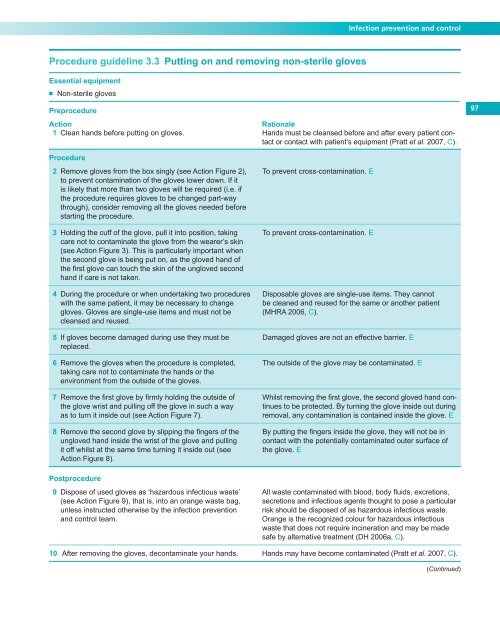Infection prevention and control - Royal Marsden Manual of Clinical ...
Infection prevention and control - Royal Marsden Manual of Clinical ...
Infection prevention and control - Royal Marsden Manual of Clinical ...
Create successful ePaper yourself
Turn your PDF publications into a flip-book with our unique Google optimized e-Paper software.
Procedure guideline 3.3 Putting on <strong>and</strong> removing non-sterile gloves<br />
Essential equipment<br />
■ Non-sterile gloves<br />
Preprocedure<br />
<strong>Infection</strong> <strong>prevention</strong> <strong>and</strong> <strong>control</strong><br />
Action Rationale<br />
1 Clean h<strong>and</strong>s before putting on gloves. H<strong>and</strong>s must be cleansed before <strong>and</strong> after every patient contact<br />
or contact with patient’s equipment ( Pratt et al. 2007 , C ).<br />
Procedure<br />
2 Remove gloves from the box singly (see Action Figure 2 ),<br />
to prevent contamination <strong>of</strong> the gloves lower down. If it<br />
is likely that more than two gloves will be required (i.e. if<br />
the procedure requires gloves to be changed part-way<br />
through), consider removing all the gloves needed before<br />
starting the procedure.<br />
3 Holding the cuff <strong>of</strong> the glove, pull it into position, taking<br />
care not to contaminate the glove from the wearer’s skin<br />
(see Action Figure 3 ). This is particularly important when<br />
the second glove is being put on, as the gloved h<strong>and</strong> <strong>of</strong><br />
the fi rst glove can touch the skin <strong>of</strong> the ungloved second<br />
h<strong>and</strong> if care is not taken.<br />
4 During the procedure or when undertaking two procedures<br />
with the same patient, it may be necessary to change<br />
gloves. Gloves are single-use items <strong>and</strong> must not be<br />
cleansed <strong>and</strong> reused.<br />
5 If gloves become damaged during use they must be<br />
replaced.<br />
6 Remove the gloves when the procedure is completed,<br />
taking care not to contaminate the h<strong>and</strong>s or the<br />
environment from the outside <strong>of</strong> the gloves.<br />
7 Remove the fi rst glove by fi rmly holding the outside <strong>of</strong><br />
the glove wrist <strong>and</strong> pulling <strong>of</strong>f the glove in such a way<br />
as to turn it inside out (see Action Figure 7 ).<br />
8 Remove the second glove by slipping the fi ngers <strong>of</strong> the<br />
ungloved h<strong>and</strong> inside the wrist <strong>of</strong> the glove <strong>and</strong> pulling<br />
it <strong>of</strong>f whilst at the same time turning it inside out (see<br />
Action Figure 8 ).<br />
Postprocedure<br />
9 Dispose <strong>of</strong> used gloves as ‘hazardous infectious waste’<br />
(see Action Figure 9 ), that is, into an orange waste bag,<br />
unless instructed otherwise by the infection <strong>prevention</strong><br />
<strong>and</strong> <strong>control</strong> team.<br />
To prevent cross-contamination. E<br />
To prevent cross-contamination. E<br />
Disposable gloves are single-use items. They cannot<br />
be cleaned <strong>and</strong> reused for the same or another patient<br />
( MHRA 2006, C ).<br />
Damaged gloves are not an effective barrier. E<br />
The outside <strong>of</strong> the glove may be contaminated. E<br />
Whilst removing the fi rst glove, the second gloved h<strong>and</strong> continues<br />
to be protected. By turning the glove inside out during<br />
removal, any contamination is contained inside the glove. E<br />
By putting the fi ngers inside the glove, they will not be in<br />
contact with the potentially contaminated outer surface <strong>of</strong><br />
the glove. E<br />
All waste contaminated with blood, body fl uids, excretions,<br />
secretions <strong>and</strong> infectious agents thought to pose a particular<br />
risk should be disposed <strong>of</strong> as hazardous infectious waste.<br />
Orange is the recognized colour for hazardous infectious<br />
waste that does not require incineration <strong>and</strong> may be made<br />
safe by alternative treatment ( DH 2006a , C ).<br />
10 After removing the gloves, decontaminate your h<strong>and</strong>s. H<strong>and</strong>s may have become contaminated ( Pratt et al. 2007 , C ).<br />
(Continued)<br />
97


